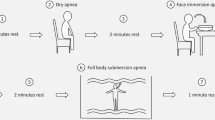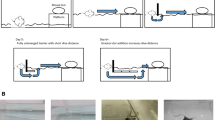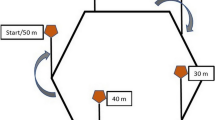Abstract
Purpose
The present study aimed to examine diurnal variation of the diving bradycardia responses on the same day.
Methods
Eighteen young men (age 26 ± 2 years; height 174.2 ± 6.0 cm; body mass 70.2 ± 8.1 kg; body fat 18.0 ± 3.8 %; mean ± standard deviation) participated in this study. Oral temperature, heart rate variability (HRV) from 5-min of electrocardiogram data, and diving bradycardia responses were measured at 0900, 1300, and 1700 hours daily. All participants performed diving reflex tests twice in the sitting position with the face immersed in cold water (1.9–3.1 °C) and apnea at midinspiration for a minimum of 30 s and as long as possible, in consecutive order.
Results
Oral temperature was found to be less in the morning (0900) than in the afternoon (1300) and evening (1700). In the frequency domain parameters of heart rate variability, the natural logarithms of high-frequency power were higher in the morning than in the evening. All participants showed bradycardia response to the two diving reflex tests. The peak values of R–R interval during the diving reflex test both for as long as possible and 30 s were longer in the morning than in the afternoon and evening.
Conclusion
Our results indicated that the maximal bradycardia during the diving reflex test exhibits a diurnal variation, with peak levels at morning and gradual decrease towards the evening. The HRV indexes show the same variation.


Similar content being viewed by others
References
Amano M, Kanda T, Ue H, Moritani T (2001) Exercise training and autonomic nervous system activity in obese individuals. Med Sci Sports Exerc 33:1287–1291
Avery DH, Dahl K, Savage MV, Brengelmann GL, Larsen LH, Kenny MA, Eder DN, Vitiello MV, Prinz PN (1997) Circadian temperature and cortisol rhythms during a constant routine are phase-delayed in hypersomnic winter depression. Biol Psychiatry 41:1109–1123. doi:10.1016/S0006-3223(96)00210-7
Bonnemeier H, Richardt G, Potratz J, Wiegand UK, Brandes A, Kluge N, Katus HA (2003) Circadian profile of cardiac autonomic nervous modulation in healthy subjects: differing effects of aging and gender on heart rate variability. J Cardiovasc Electrophysiol 14:791–799
Bove AA, Lynch PR, Connell JV Jr, Harding JM (1968) Diving reflex after physical training. J Appl Physiol 25:70–72
Furlan R, Guzzetti S, Crivellaro W, Dassi S, Tinelli M, Baselli G, Cerutti S, Lombardi F, Pagani M, Malliani A (1990) Continuous 24-hour assessment of the neural regulation of systemic arterial pressure and RR variabilities in ambulant subjects. Circulation 81:537–547
Heath ME, Downey JA (1990) The cold face test (diving reflex) in clinical autonomic assessment—methodological considerations and repeatability of responses. Clin Sci 78:139–147
Hilz MJ, Stemper B, Sauer P, Haertl U, Singer W, Axelrod FB (1999) Cold face test demonstrates parasympathetic cardiac dysfunction in familial dysautonomia. Am J Physiol 276:R1833–R1839
Huikuri HV, Kessler KM, Terracall E, Castellanos A, Linnaluoto MK, Myerburg RJ (1990) Reproducibility and circadian rhythm of heart rate variability in healthy subjects. Am J Cardiol 65:391–393
Kawakami Y, Natelson BH, DuBois AR (1967) Cardiovascular effects of face immersion and factors affecting diving reflex in man. J Appl Physiol 23:964–970
Khurana RK (2007) Cold face test: adrenergic phase. Clin Auton Res 17:211–216. doi:10.1007/s10286-007-0422-3
Khurana RK, Wu R (2006) The cold face test: a non-baroreflex mediated test of cardiac vagal function. Clin Auton Res 16:202–207. doi:10.1007/s10286-006-0332-9
Kinoshita T, Nagata S, Baba R, Kohmoto T, Iwagaki S (2006) Cold-water face immersion per se elicits cardiac parasympathetic activity. Circ J 70:773–776
La Marca R, Waldvogel P, Thorn H, Tripod M, Wirtz PH, Pruessner JC, Ehlert U (2011) Association between cold face test-induced vagal inhibition and cortisol response to acute stress. Psychophysiology 48:420–429. doi:10.1111/j.1469-8986.2010.01078.x
Ministry of Health Labour and Welfare of Japan (2010) Dietary reference intakes for Japanese. Daiichi Shuppan, Tokyo
Molgaard H, Sorensen KE, Bjerregaard P (1991) Circadian variation and influence of risk factors on heart rate variability in healthy subjects. Am J Cardiol 68:777–784
Morf J, Schibler U (2013) Body temperature cycles: gatekeepers of circadian clocks. Cell Cycle 12:539–540. doi:10.4161/cc.23670
Ninio DM, Hill AM, Howe PR, Buckley JD, Saint DA (2008) Docosahexaenoic acid-rich fish oil improves heart rate variability and heart rate responses to exercise in overweight adults. Br J Nutr 100:1097–1103. doi:10.1017/S0007114508959225
Pecanha T, Prodel E, Bartels R, Nasario O, Paula RB, Silva LP, Laterza MC, Lima JRP (2014) 24-h cardiac autonomic profile after exercise in sedentary subjects. Int J Sports Med 35:245–252. doi:10.1055/s-0033-1349873
Ptaszynski P, Kaczmarek K, Klingenheben T, Cygankiewicz I, Ruta J, Wranicz JK (2013) Noninvasive assessment of autonomic cardiovascular activity in patients with inappropriate sinus tachycardia. Am J Cardiol 112:811–815. doi:10.1016/j.amjcard.2013.04.057
Reyners AK, Tio RA, Vlutters FG, van der Woude GF, Reitsma WD, Smit AJ (2000) Re-evaluation of the cold face test in humans. Eur J Appl Physiol 82:487–492. doi:10.1007/s004210000217
Sharma P, Pande B, Chandrakar P, Pati AK (2015) Comparative study of circadian variation in oral, tympanic, forehead, axillary and elbow pit temperatures measured in a cohort of young university students living their normal routines. Biol Rhythm Res 46:103–112. doi:10.1080/09291016.2014.950091
Sjoberg N, Brinkworth GD, Wycherley TP, Noakes M, Saint DA (2011) Moderate weight loss improves heart rate variability in overweight and obese adults with type 2 diabetes. J Appl Physiol (1985) 110:1060–1064. doi:10.1152/japplphysiol.01329.2010
Stromme SB, Kerem D, Elsner R (1970) Diving bradycardia during rest and exercise and its relation to physical fitness. J Appl Physiol 28:614–621
Task Force (1996) Heart rate variability. Standards of measurement, physiological interpretation, and clinical use. Task Force of the European Society of Cardiology and the North American Society of Pacing and Electrophysiology. Eur Heart J 17:354–381
Thayer JF, Lane RD (2007) The role of vagal function in the risk for cardiovascular disease and mortality. Biol Psychol 74:224–242. doi:10.1016/j.biopsycho.2005.11.013
Thayer JF, Yamamoto SS, Brosschot JF (2010) The relationship of autonomic imbalance, heart rate variability and cardiovascular disease risk factors. Int J Cardiol 141:122–131. doi:10.1016/j.ijcard.2009.09.543
West NH, McCulloch PF, Browne PM (2001) Facial immersion bradycardia in teenagers and adults accustomed to swimming. Auton Neurosci 94:109–116. doi:10.1016/S1566-0702(01)00340-X
Acknowledgments
Heartfelt thanks are due to the subjects who participated in this study and their guardians. This study was supported by The Ministry of Education, Science, Sports and Culture of Japan under grant (Grant Nos. 25560376 and 26750340).
Author information
Authors and Affiliations
Corresponding author
Ethics declarations
Conflict of interest
On behalf of all authors, the corresponding author states that there is no conflict of interest.
Rights and permissions
About this article
Cite this article
Konishi, M., Kawano, H., Xiang, M. et al. Diurnal variation in the diving bradycardia response in young men. Clin Auton Res 26, 135–140 (2016). https://doi.org/10.1007/s10286-016-0342-1
Received:
Accepted:
Published:
Issue Date:
DOI: https://doi.org/10.1007/s10286-016-0342-1




